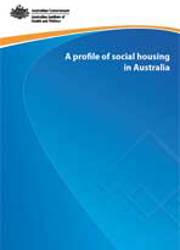Summary
This report profiles social housing delivered under the 2003 Commonwealth State Housing Agreement (CSHA) and the first six months of the National Affordable Housing Agreement (NAHA), which came into effect 1 January 2009.
To the end of 2008, the CSHA funded housing assistance for Australians in need of support to meet their accommodation needs. Social housing was the primary vehicle for delivering this assistance, with public housing and community housing, both mainstream and targeted for Indigenous Australians, offering an affordable and more secure alternative to private rental. The most recent CSHA, which commenced in 2003 and ended on 31 December 2008, provided over 400,000 dwellings each year, for households in need.
During this time the sector saw increases in community housing dwellings and a simultaneous decline in public rental housing stock. The demographic profile of households in social housing changed little over the course of the 2003 CSHA: households were mostly on very low incomes, with the majority receiving a government pension as their main source; single people made up the highest proportion of household types, and were older than the general population.
With smaller than average households residing in dwellings that in almost 50% of cases are three bedrooms or more, overcrowding is rare in public rental housing, state owned and managed Indigenous housing (SOMIH) and mainstream community housing. Indigenous community housing (ICH) shows higher rates of overcrowding although the limited coverage and quality of data available on this sector limits comparability with other social housing programs.
As social housing generally offers affordable rents and some security of tenure, tenants largely report being satisfied. As might be expected then, the majority (55%) of households in public rental housing and 44% of households in mainstream community housing had lived in the same dwelling for more than 5 years.
At the close of the 2003 CSHA, the profile of social housing in Australia reflected the high demand for assistance. By 2008–09:
- occupancy rates were over 90% across social housing and higher in Major cities
- allocations to public rental housing were tightly rationed, with over 60% of newly assisted households assessed as being in ‘greatest need’—more than double the rate of these allocations in 2003–04
- over 170,000 households were on waiting lists for public rental housing
- almost half of the new allocations to social housing were to mainstream community housing.
In order to address growing concerns about affordability in the private market, the National Affordable Housing Agreement (NAHA), introduced from 1 January 2009, and associated National Partnership Agreements, expanded the role of governments in supporting Australians to meet their housing needs. Initiatives such as the National Rental Affordability Scheme (NRAS) and various housing reforms are intended to address shortages in affordable housing and alleviate the pressure on the current social housing system. Whilst the focus has been widened, social housing will continue to play a key role in the provision of housing assistance in Australia.
Preliminary material: Acknowledgments; Abbreviations; Symbols
1. Introduction
- Data interpretation guide
2. The people in social housing
- Demographic profile
- Changes in households over the 2003 CSHA
3. Social housing dwellings
- Location
- Dwelling type and size
- Dwelling condition and availability
4. Providing social housing
- Dwelling management
- Assisting those most in need
- Sustainability of tenure
- Transfers and exits
5. Social housing outcomes and social inclusion
- Improving the lives of tenants
- Employment and educational participation
- Connecting with services and the community
- Having a say
6. Moving on: from the CSHA to the NAHA
- Social housing under the NAHA
- Conclusion
End matter: Appendix tables; Glossary; References; List of tables; List of figures



